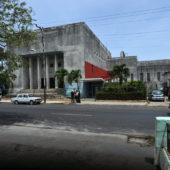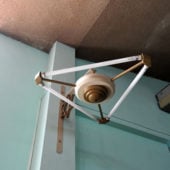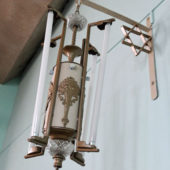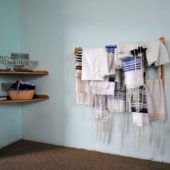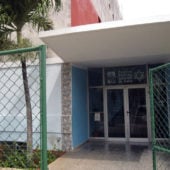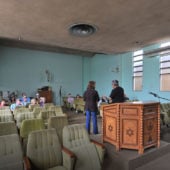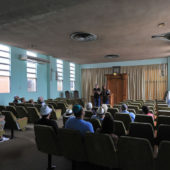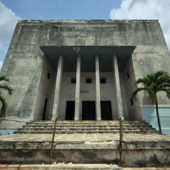One of three active synagogues in Havana, the Sefardic Synagogue affiliated with Conservative Judaism in October of 1995.
Jews arrived in Cuba shortly after the expulsion of Jews from Spain in 1492. Popular lore states that three Jews came with Columbus: Luis de Torres on the Santa Maria, Juan de Cabrera on La Pinta and Rodrigo de Triana on La Nina. All three were Marranos, forced Jewish converts to Catholicism. In spite of their practicing the Catholic faith, the hand of the inquisition still reached for them. The first trial of the Inquisition in Havana was against a Jew, Francisco Gomez de Leon, executed in Cartagena, after, of course, confiscating his large fortune, which without doubt was the cause of his persecution.
During the 16th and 17th centuries, many Jews immigrated to Cuba from Brazil, having been persecuted under the Portuguese. The new Jewish immigrants founded trade in Cuba and by the 18th century, Cuban Jewish trade routes included Amsterdam and Hamburg. However, Jews were harassed and many Jews assimilated into Cuban society. At the end of the 1800s, Jews from the Dutch Antilles settled in Cuba. They supported Jose Marti, who freed Cuba from Spanish colonial rule in 1898. After the Spanish-American War, many American Jewish war veterans moved to Cuba and founded a congregation in Havana in 1904. Cuban Jews were involved in all aspects of society and trade. Jews were instrumental in the sugar cane business; they transported sugar cane from Madeira to Brazil and then on to the Antilles. Jews were the first people to use protective cloth to protect tobacco plants from the extremes of weather. This is still being done today to produce the finest quality of tobacco in the world. Many Jewish traders pursuing business in the New World set up outposts on Cuba.
After the Spanish-American War, the Jewish presence became permanent. American Ashkenazi Jews (born in Europe) immigrated to Cuba to work for U.S.-owned plantations and businesses. In 1906, eleven founded the United Hebrew Congregation, a Reform synagogue, that conducted its services in English. This was officially considered to be the beginning of the Jewish community in Cuba. A large number of Jews immigrated to Cuba in 1910 and 1920, including Sephardic Jews from Turkey, as a stop-over point on their way to the United States. However, there was a quota for immigrants allowed into the United States, so many stayed in Cuba, due to the fact that there wasn’t much anti-Semitism. Many of these new immigrants prospered in Cuban’s garment trade. By 1924, 24,000 Jews lived in Cuba. In the 1930s, a central Jewish committee was established as a base for all of the Jewish groups.
At the time of the Castro lead Socialist Revolution in 1959, there were approximately15,000 Jews in Cuba. About 75% of the Jewish population lives in Havana. Jewish people tend to be merchants and entrepreneurial, therefore socialism was not attractive to them and approximately 94% of Cuba’s Jewish population fled after the Revolution. There are less than 2,000 Jews remaining in Cuba, most living in Havana. Jews and Christians were persecuted after the Revolution and had restricted access to jobs and universities. However, they were still allowed to practice their religion, distribute kosher food and to receive donations from other nations. In 1973, Cuba severed diplomatic relations with Israel and is considered to be one of Israel’s worst enemies. In the late 1960s a number of Jews were sent to forced labor camps, having been accused as political dissenters, religious peoples, gays and/or exit applicants. Jewish activists were constantly under surveillance. Predictably, Jewish life went more “underground,” but has still survived. In the 1970s , a synagogue and school in Havana were both closed. In the 1980s, a further synagogue was closed. Throughout the 1980s, even Havana’s largest synagogue, the Patronato, had difficulty forming a minyan (a quorum of ten men required for a religious service). Cuban Jewry faced assimilation and its elders were concerned about the community’s future.
In 1991 a law was passed permitting members of the Communist party to have religious affiliations. This was a significant step in rejuvenating Judaism in Cuba. Due to Cuba’s economic problems, its Jewish community is among the poorest in the world. The JDC (American Joint Distribution Committee has worked to help build up Cuban Jewry and to aid the people on a social level. As of 2011, there are three synagogues in Havana, which survived the Revolution, to serve the 1,000 Jews in the city today: El Patronata (Beth Shalom), Centro Sefardi, and Adath Israel de Cuba. El Patronato is a Conservative synagogue, Centro Sefardi practices the Sephardic rite and Adath Israel is Orthodox.
The Centro Sefardi building was constructed in the Vedado area in 1950 when the community moved from Habana Vieja where its first synagogue had become unsound. The original Vedado synagogue building is an imposing Bauhaus style concrete structure, with a columned portico in the front and a broad swath of stairs leading into the entrance. That building is being re-purposed as a performance hall and newer building has been constructed adjacent to it. The prayer room is a purpose-built room with aquamarine walls, brown carpeting and a brown ceiling, illuminated naturally by rectangular windows, which line both side walls. A beautiful, large tivah (reader’s desk) light wood inlaid with darker wood, featuring spiraled columns and stars-of-David and a menorah, is situated in the center of the room on a very small platform. At the far end of the room is a gold curtained wall and in the center is placed the Aron Kodesh, simply carved of wood, not unlike a quality media cabinet. Purpose-built, olive-green upholstered chairs featuring wood armrests fill the sanctuary.
The Sephardic community represents approximately 60% of the Cuban Jewish population, with about 80 families (250 people) attending the Sephardic Center. The Sephardic Center offers Jewish education and youth and young adult programs. It serves Shabbat lunches and dinners and has begun a new Food Aid Program that assists fifty families that are unable to travel to the center, distributing items of need such as clothes, soap, toothpaste and toothbrushes. It is financed by the international Jewish community.

